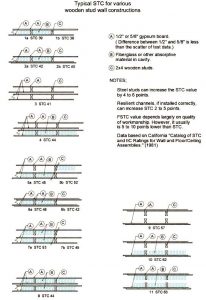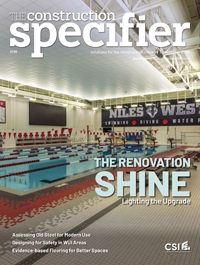Cutting through the noise on wall construction

The effect of background sound in the listener’s environment is evident in Figure 2. Lowering the background sound 10 dB requires almost a 10-point increase in NIC to maintain the same privacy. NC-25 is the recommended background sound for sleeping. NC-35 is typical of a quiet environment, similar to daytime conditions in a residential setting. Obviously, background sound in the listener’s environment is helpful in providing speech privacy, but it is not a substitute for good wall construction.
Figure 2 provides some insight into requirements for speech privacy. However, it should not be taken as a recommended design practice.
Figure 2 makes use of NR and NIC that incorporated issues of common wall size and acoustical absorption in the listener’s room. Experience dictated the design STC for a wall should be at least 10 points greater than the expected NIC. For an NC-35 background and standard speaking voice, the chart suggests NIC 30 or greater for confidential privacy. One should specify a STC 45 to 50 wall construction, and pay attention to potential flanking paths. STC rating for any given wall design can be improved by sealing all possible flanking paths (i.e. wall perimeter), eliminating back-to-back wall outlets, providing an acoustical break in the wall system, and acoustically sealing all penetrations.
STC-50 walls are specified in many building codes as minimum between common walls of apartments and condominiums. However, STC 50 is inadequate for guarding against very high voice levels or low background sound.
Conclusion
To reiterate, privacy is a continuum, and not a sharp division as shown in Figure 1. Informed judgment is an essential part of providing the degree of privacy expected by the occupants of the multifamily housing. Persons moving to a condominium from a private residence may require more privacy than someone who has lived previously in a multifamily environment.
Obviously, the larger the area of a wall between two rooms, the more acoustical power will be transmitted from one space to the other. So, to better compare the properties of two walls, a correction must be made for the relative wall areas. Also, the more acoustical absorption in the receiving room, the more transmitted sound is absorbed, thus lessening the noise level in the space. A correction for the absorption must also be made to compare two wall constructions. To fully complete the picture, other similar measures such as NR and NIC are used. All STC and ASTC tests start out with the same basic measurements—the numerical difference between the sound level (in decibels) on the noise-source side of the wall and the noise-receiver side of the wall. For NC and NIC, no correction is made for common wall area or acoustical absorption in the receiving room. This difference is acoustical noise reduction.
Experience has shown ASTC and NIC are generally 5 to 10 dB lower than the corresponding STC for the same wall construction, and can be as much as 15 dB lower with poor workmanship. For example, if STC is 5 dB higher than ASTC for a given wall construction, three times as much sound power is transmitted through the ASTC wall than through the STC wall. A 10-dB difference translates to the transmission of 10 times as much sound power and a 15-dB difference is 31 times the sound power. If sound transmission is a critical issue, it is suggested close observation be maintained as walls are built to avoid flanking paths. Several wooden stud wall types are shown with their rated STC values in Figure 4.
As illustrated in Figure 2, background sound is an important factor in AI. Background sounds from the HVAC system are the primary concern in most cases. A low background sound should be assumed to be conservative. Sleeping areas should have low background sound. Other rooms are more likely to have NCs in the range of 30 to 35.
The demand for soundproof spaces and increased privacy is continuing to grow. It is important these needs are taken into account during the design phase.




